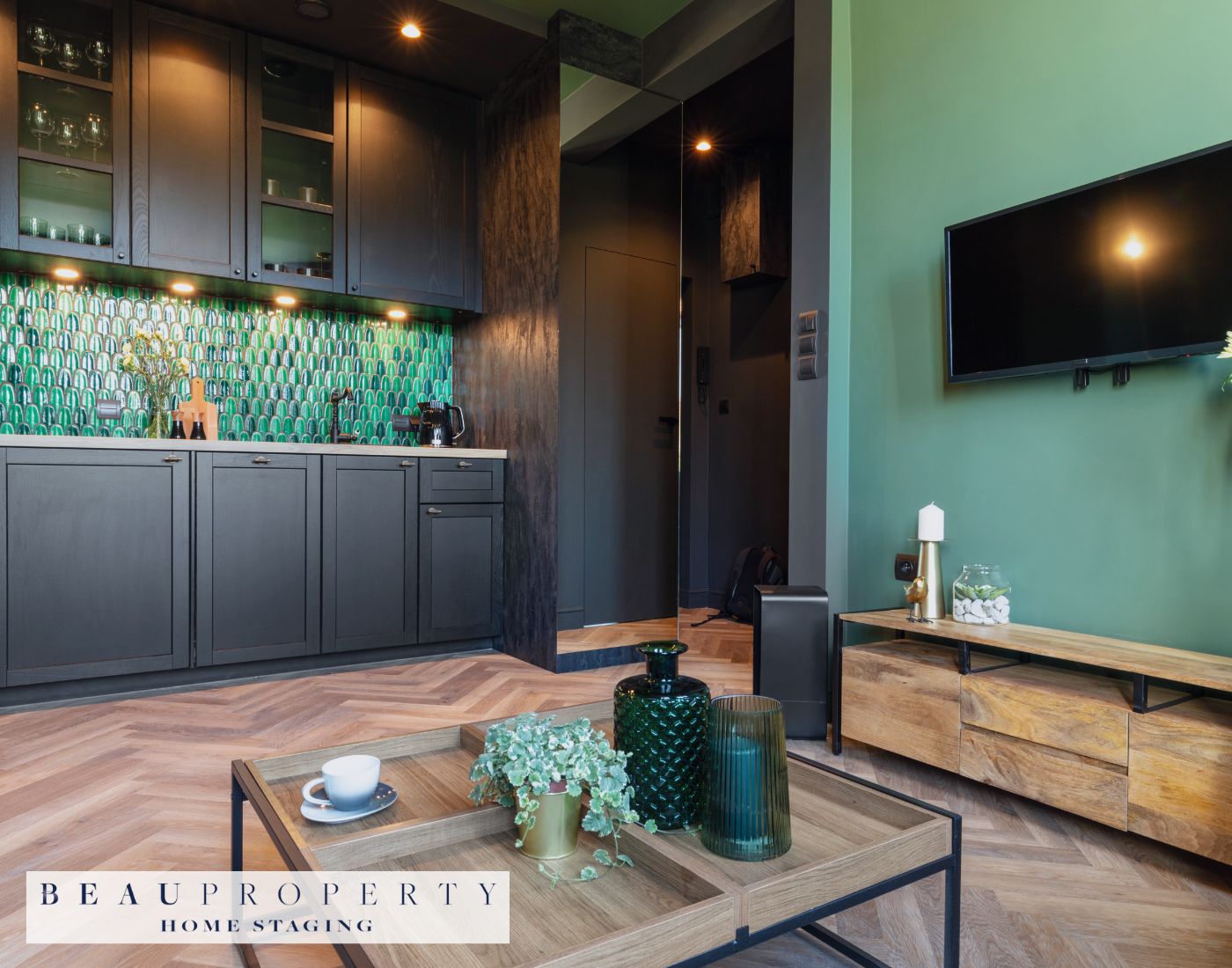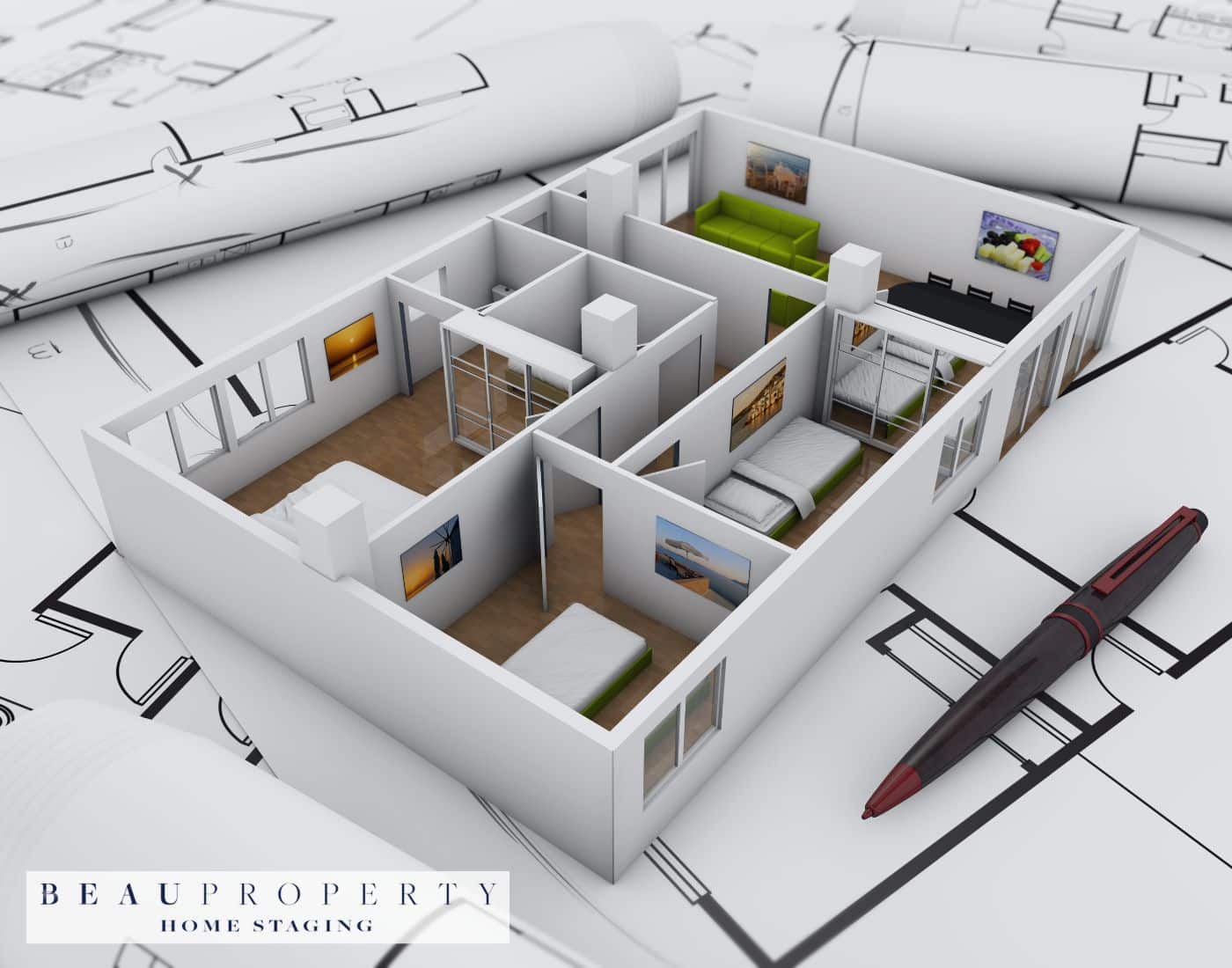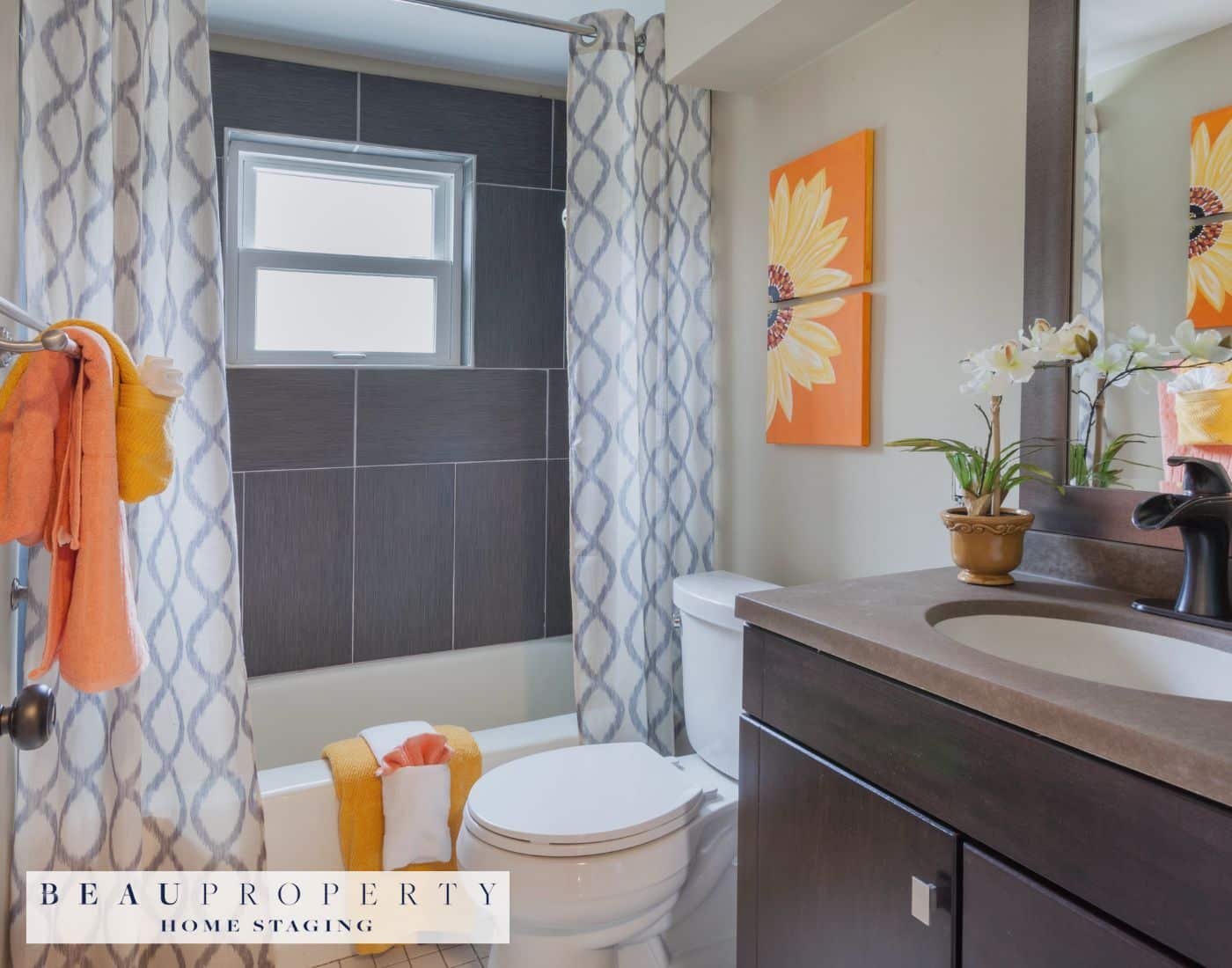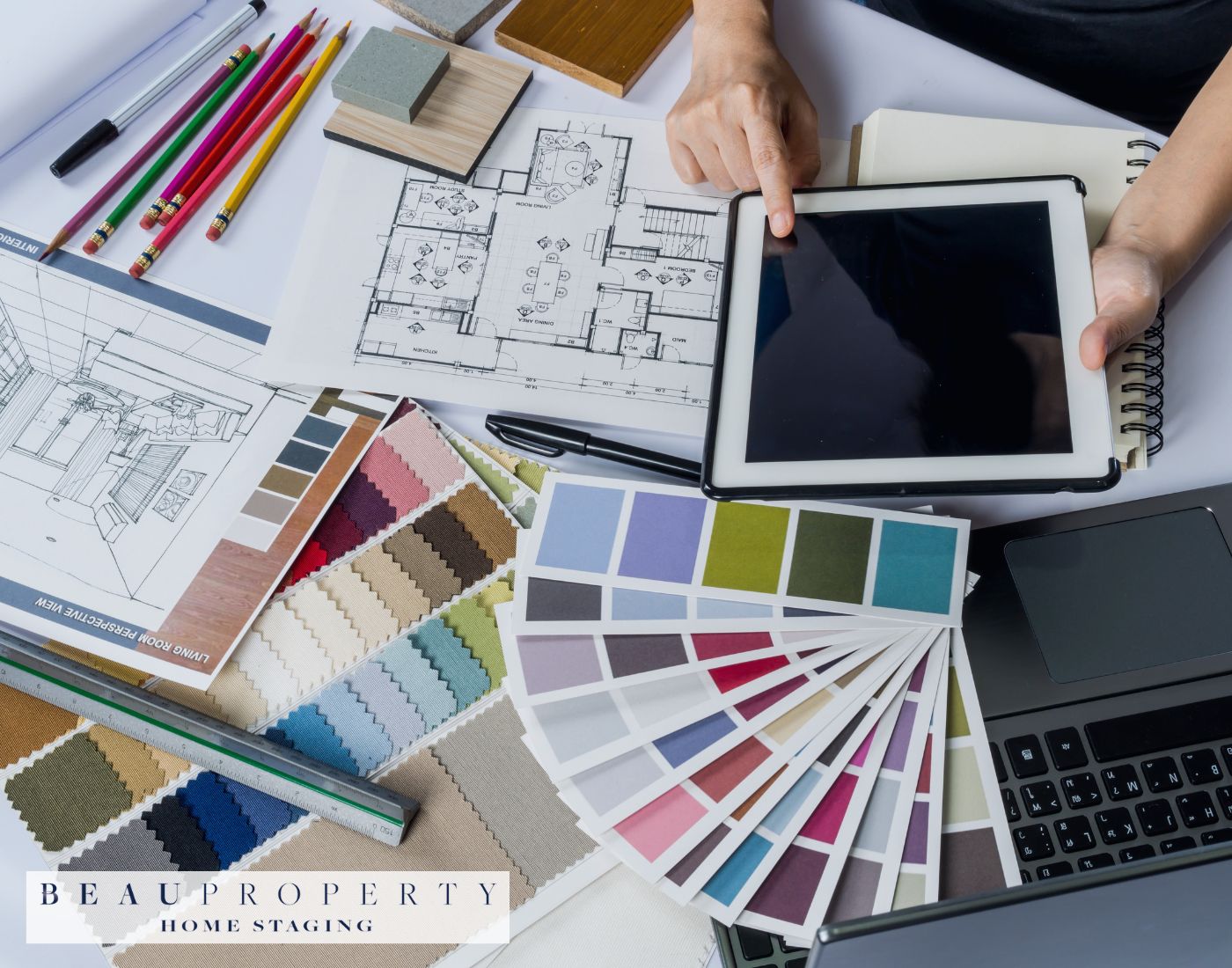What is Home Staging?
Home staging is the process of preparing a private residence for sale in the real estate market. It involves redecorating, rearranging furniture, and performing various aesthetic adjustments to present the home in its best possible light. Think of it as “setting the stage” for potential buyers to imagine themselves living in the property.
Definition of Home Staging
At its core, home staging focuses on showcasing a home’s strengths and minimising its weaknesses. By employing a combination of interior styling and strategic furniture placement, staging helps to create appealing spaces that captivate potential buyers from the moment they walk through the door. This isn’t about creating a lived-in home; it’s about creating an environment that buyers can envision as their own.
Purpose of Staging When Selling a Property
The primary purpose of staging a home is to significantly enhance its market appeal, thereby facilitating a quicker sale at a higher price. Properly staged homes often stand out in the market, which can lead to competitive offers. According to the National Association of Realtors, nearly a third of real estate agents report that staging increases the dollar value offered by buyers, usually by 1% to 5% compared to similar unstaged homes.
Staging also helps potential buyers to understand the full potential of the space. It addresses common buyer challenges, such as difficulty envisioning how to use an empty or cluttered space. By presenting a property at its best, staging assists buyers in seeing how they can make the space their own.
Difference Between Staging and Decorating
While home staging and interior decorating both involve design principles, their purposes are fundamentally different. Staging is about appeal and broadening the market for a swift sale. It involves depersonalising the space, focusing on neutral colours, and highlighting the home’s best features to attract the widest possible audience.
Conversely, decorating is tailored to the current homeowner’s individual tastes and lifestyle, aiming to create a comfortable and personalised living environment. Interior design often includes long-term elements and customisations that suit the owner’s specific needs. In staging, the personal aspect is stripped away to ensure potential buyers can see the property as a blank slate they can transform into their dream home.
By understanding the distinction between staging and decorating, homeowners and real estate agents can better prepare a property for sale, creating an environment that resonates with buyers on an emotional level and showcases the home’s full potential.
The Importance of Home Staging
Impact on Sale Price and Time on Market
Home staging plays a vital role in influencing both the sale price and time on the market for properties. Studies have consistently shown that staged homes sell significantly faster and for a higher price compared to their unstaged counterparts. Investing in staging can yield an impressive return on investment, with sellers seeing a return of over 7.1% by investing just 1.3% of the home’s value in staging.
Moreover, staging can reduce the time a property spends on the market by up to 73%. This efficiency not only benefits sellers wanting to close the deal quickly but also enhances the agent’s ability to move on to the next listing, thus improving their overall productivity.
Creating Emotional Connections with Potential Buyers
The emotional appeal of a staged home cannot be underestimated. When potential buyers walk into a well-staged property, they often experience an emotional connection that goes beyond the physical layout and features of the home. The psychology behind home staging focuses on creating an atmosphere that enables buyers to envision their future lives in the space. Home staging transforms a property viewing into a walk-through of future memories and possibilities, promoting a sense of intimacy and rapport.
Staging can make a home feel welcoming and inviting, enabling prospective buyers to picture themselves living there. These emotional connections are crucial as they can significantly influence buying decisions, often tipping the scale in favour of making an offer.
Key Areas to Focus on When Staging
When staging your home for sale, focusing on key areas can significantly impact buyers’ perceptions and emotional connections. Here’s a breakdown of the areas you should prioritise and the techniques to utilise for optimal staging.
Curb Appeal and First Impressions
First impressions start at the curb. The exterior of your home is the initial touchpoint for a potential buyer. A well-maintained front yard, a freshly painted front door, clean windows, and an inviting porch can set the right tone. Simple touches like planting fresh flowers, adding outdoor lighting, or updating the mailbox can make a huge difference. A welcoming exterior acts as a prelude to what lies inside, creating an enticing atmosphere from the get-go.
Living Rooms, Kitchens, and Primary Bedrooms
Focusing on the most lived-in and high-impact spaces, such as the living room, kitchen, and primary bedroom, is crucial.
Living Rooms
The living room often serves as a communal space; hence, it should look comfortable yet stylish. Arrange furniture to promote conversation and easy navigation. A focal point, such as a fireplace or a large window, can anchor the room. Use neutral colours and minimalistic decor to appeal to a wide audience without overwhelming the space.
Kitchens
For many, the kitchen is the heart of the home. Ensure it is spotless, from countertops to appliances. Declutter and depersonalise by removing anything overly specific, such as mismatched utensils or personal knick-knacks. Consider minor updates, like new cabinet hardware or a fresh coat of paint, to modernise the space on a budget.
Primary Bedrooms
Primary bedrooms should exude tranquillity and spaciousness. Use neutral bedding and minimalist decor to create a calming environment. Make sure the room is free from personal items, allowing potential buyers to envision their own belongings in the space.
The 3-Foot 5-Foot Rule in Staging
The 3-foot 5-foot rule is a guideline to ensure both close-up and distant views of a room are appealing. Most people first notice fine details, like decor and the condition of surfaces, from about 3 feet away. Therefore, tidy up and ensure all details are immaculate, such as well-made beds and clean surfaces. From 5 feet away, the overall design and flow of the room become apparent. Arrange furniture to highlight key features and maintain a sense of openness and ease of movement. This dual focus on details and overall appearance creates a balanced and welcoming environment.
When staging your home, paying attention to curb appeal, core living spaces, and the nuanced details encapsulated by the 3-foot 5-foot rule can make a substantial difference. These efforts not only enhance visual appeal but also help potential buyers form an emotional connection with the property, making it more likely for them to envision it as their future home.
Essential Home Staging Techniques
Staging your home effectively can make the difference between a quick sale at a high price and a prolonged listing. Let’s delve into the essential techniques that can transform your property into a buyer’s dream.
Decluttering and Depersonalising
One of the first steps in home staging is decluttering and depersonalising your space. Excess clutter can make a home appear smaller and less inviting. Start by removing non-essential items from rooms, countertops, and storage areas. Less is more when it comes to creating an open and spacious environment.
Depersonalising is equally important. Potential buyers need to envision themselves in the space, not be reminded of the current owners. Remove personal photographs, collections, and any items that reflect your personal taste. Instead, use neutral décor that appeals to a broader audience.
Cleaning and Making Necessary Repairs
A clean home is a must when it comes to staging. Prospective buyers will inspect every nook and cranny, so it’s essential to ensure every part of the property is spotless. Pay special attention to:
- Windows and mirrors
- Kitchen appliances
- Bathroom fixtures
- Floors and carpets
Aside from cleanliness, making necessary repairs is crucial. Fix leaky faucets, squeaky doors, and cracked tiles. These may seem minor, but they can significantly impact a buyer’s impression. Addressing these issues upfront shows that the home is well-maintained and move-in ready.
Updating Décor with Neutral Colours and On-Trend Styles
Updating the décor can elevate the aesthetic appeal of your property. When selecting colours, opt for neutral shades like whites, greys, and beiges. These colours create a clean and modern look, making it easier for buyers to imagine their furnishings in the space.
Additionally, integrating on-trend styles can give your home a contemporary edge. Here are some elements to consider:
- Minimalist furniture
- Light fixtures with a modern touch
- Simple, elegant window treatments
- A few trendy accessories for a pop of style
Remember, the goal is to create a welcoming, impersonal space that allows buyers to picture themselves living there.
Staging Vacant vs. Occupied Homes
Navigating the nuances of staging vacant vs. occupied homes requires an understanding of the distinct strategies and challenges involved in each. Both scenarios offer unique advantages and obstacles that must be managed to present the property in its best light.
Challenges of Staging an Empty Property
Staging a vacant home brings its own set of hurdles. An empty property can feel cold and uninviting, creating a less-than-ideal first impression. Without furniture and decor, it can be hard for potential buyers to visualise the full potential of each space. A barren room can also appear smaller and less functional than it actually is, making it tough for buyers to see how they would utilise the area.
Furthermore, maintaining a vacant home can be troublesome. Properties left unoccupied are susceptible to issues such as water damage, electrical faults, and illegal activities like burglary or vandalism. Regular maintenance, such as cleaning and security, must be factored into the staging process.
Strategies for Making Vacant Spaces Feel Inviting
To overcome these challenges, strategic staging can transform an empty house into a warm, inviting space. Here are some effective techniques:
- Furniture and Decor: Renting and strategically placing furniture and accessories can define the purpose of each room and help prospective buyers visualise their own belongings within the space.
- Area Rugs and Mirrors: Adding area rugs and mirrors can make rooms feel more complete and spacious. Rugs bring warmth and texture, while mirrors reflect light, making rooms appear larger and more inviting.
- Kitchen and Bathroom Accessories: Small touches like new towels, fresh flowers, and stylish containers can enhance these key areas, making the home more appealing.
- Virtual Staging: For a cost-effective alternative, virtual staging can create an inviting atmosphere using digital furniture and decor, aiding buyers in visualising the space as their own.
Working with Existing Furniture in Occupied Homes
Occupied homes pose different challenges, primarily centred on balancing the homeowner’s presence with the need to create a neutral, universally appealing space.
- Decluttering and Depersonalising: One of the first steps in staging an occupied home is to declutter and depersonalise. This means removing personal items such as family photos and excess furniture to create a clean, neutral environment. This is crucial for preventing potential buyers from feeling like they’re intruding on someone else’s space and helping them visualise their own life in the home.
- Strategic Rearrangement: Stagers often work with the existing furniture and decor, rearranging and sometimes even replacing items to enhance the space’s appeal. This strategy is cost-effective as it minimises rental fees for new furniture.
- Maintaining the Staged Look: Homeowners must maintain the staged appearance throughout the selling process, which can be difficult, especially with daily living needs. Pet owners or families with children might find it challenging to keep the home in show-ready condition consistently. Professional stagers can offer advice on how to simplify this process.
While staging a vacant property involves breathing life into empty spaces, staging an occupied home focuses on creating a universally appealing aesthetic without personal bias. Both approaches aim to highlight the property’s strongest features and maximise its market appeal, ultimately aiding in a faster, more profitable sale.
The Role of Professional Stagers
As any seasoned real estate agent will tell you, the right presentation can make or break a sale. That’s where professional home stagers come in. Their expertise can transform a property, making it irresistible to potential buyers. Let’s break down the benefits, costs, and collaborative advantages of hiring a professional stager.
Benefits of Hiring a Professional Stager
Professional stagers offer numerous advantages, making them a worthwhile investment for many sellers.
- Higher Sale Price: One of the most appealing benefits of staging is the potential for a higher sale price. Homes staged by professionals often attract more interest and competition, which correlates with higher offers. On average, staged homes sell for up to 20% more than non-staged counterparts.
- Faster Sale: Staged homes tend to sell more quickly, reducing the time a property spends on the market. This speed is vital as it can alleviate the stress and cost of prolonged selling periods.
- First Impressions Matter: It takes potential buyers just a few seconds to decide if they like a home. By presenting a property in its best light right from the start, professional stagers can significantly impact buying decisions.
- Standing Out Online: 97% of buyers look for homes online. Quality staging can make a listing pop, leading to more views and prospective buyers.
Collaboration Between Stagers, Homeowners, and Real Estate Agents
Successful staging is a team effort involving homeowners, real estate agents, and stagers.
- Effective Communication: Open dialogue between all parties ensures that everyone’s vision aligns. Homeowners and agents can share insights about the property’s unique features, while stagers bring expert knowledge on enhancing those features.
- Mutual Support: Homeowners and real estate agents can lean on stagers for guidance on trends and best practices. Simultaneously, stagers can rely on agents for market insights and homeowner cooperation in maintaining the staged environment during the sale process.
Professional stagers nail the balancing act of aesthetics and functionality, ensuring properties shine in their best light. It’s clear that the advantages of working with such professionals heavily outweigh the initial costs, making it a smart decision for many sellers.
Home Staging for Online Listings
Importance of Quality Photos and Virtual Tours
When it comes to home staging, high-quality photos and virtual tours are non-negotiable. In today’s digital age, 90% of potential homebuyers use the internet as their primary tool for property hunting. Homes with professional photos receive up to 118% more online views, making them crucial marketing tools.
Professional images evoke emotional responses and significantly elevate the property’s perceived value. Listings with high-quality photos not only attract more viewers but also often sell faster and for higher prices. Virtual tours, on the other hand, offer immersive experiences that allow potential buyers to “walk through” the property without physically being there. This added layer of engagement can expedite the decision-making process.
Highlighting Key Features for Online Viewers
To attract online buyers, it’s essential to highlight your home’s best features. Begin by focusing on aspects that stand out. High-resolution photos and virtual tours should showcase features like modern kitchens, updated bathrooms, and spacious living areas. For instance, a well-lit, organised kitchen or a unique living room setup can draw potential buyers in.
When planning your photoshoot, ensure ample natural light floods into the space, accentuating the home’s warmth and making it appear larger. Be strategic in which photos you place first in your online listing; the initial images should be the most compelling ones. Additionally, consider employing virtual staging tools to furnish empty spaces, making them look more appealing without the hassle of moving actual furniture.
Creating a Strong First Impression in Digital Listings
Making a strong digital first impression is vital. Here’s how to ensure your online listing packs a punch:
- Declutter and Depersonalise: Remove personal items and excess furniture to make spaces look more functional and less cramped.
- Optimise Lighting: Natural lighting is your best friend. Open blinds and curtains to let in light, making interiors look inviting.
- Professional Photography: Use a real estate photographer experienced in capturing homes to deliver crisp, clear, and attractive photos.
- Virtual Tours: Incorporate 3D home tours. Listings with such interactive elements receive more views and save more frequently by potential buyers.
- Compelling Descriptions: Accompany images with well-crafted descriptions that highlight unique features, recent upgrades, or other selling points.
Effective staging for online listings extends beyond just good photos. A balance of high-quality visuals and engaging, informative content can turn clicks into showings, and showings into offers. Elevate your digital curb appeal to ensure potential buyers can imagine themselves in the space before they ever set foot inside.
Your home is now ready to make a lasting first impression online. But, getting potential buyers to your listing is only half the battle. Ensuring they can see themselves in your home is key to converting views into offers. This involves collaborating closely with professional stagers, real estate agents, and leveraging the latest digital tools to achieve the best outcomes.








